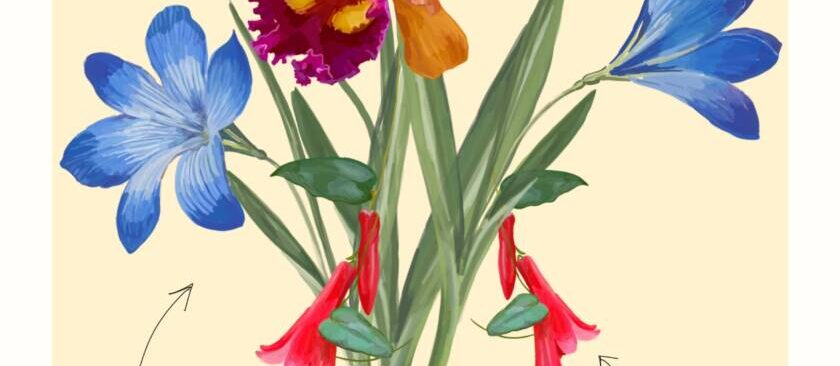Plants and flowers of all shapes, sizes and colours exist thanks to the drastic variation of climates we have around the world. From the tropical treasures in South America to the wonderful woodlands of Europe, there’s no shortage of natural beauty to be found in every corner of the planet.
To celebrate these wild and wonderful plants and flowers, let us whisk you away on a tour of the world’s continents and the flowers found in or native to the different areas. We’ve switched on our creative brains and designed bouquet concepts inspired by some of the most fabulous flowers that can be seen on each of the world’s continents. Whether you’re an avid nature lover trying to decide where in the world to cruise around on your next holiday or you’re simply interested in which flowers grow where and why, you’re sure to be captivated by our designs and interesting facts below.
Disclaimer: The designs below are for entertainment purposes only. Cruise Nation does not recommend or endorse any re-creations of the following bouquets, putting these flowers together or picking these flowers. Be warned that some might not last as cut flowers or survive alongside the other flowers and may also be poisonous/harmful to humans or pets.
The designs are solely intended to celebrate the beauty of flowers found around the world that people can see on their travels.
North America
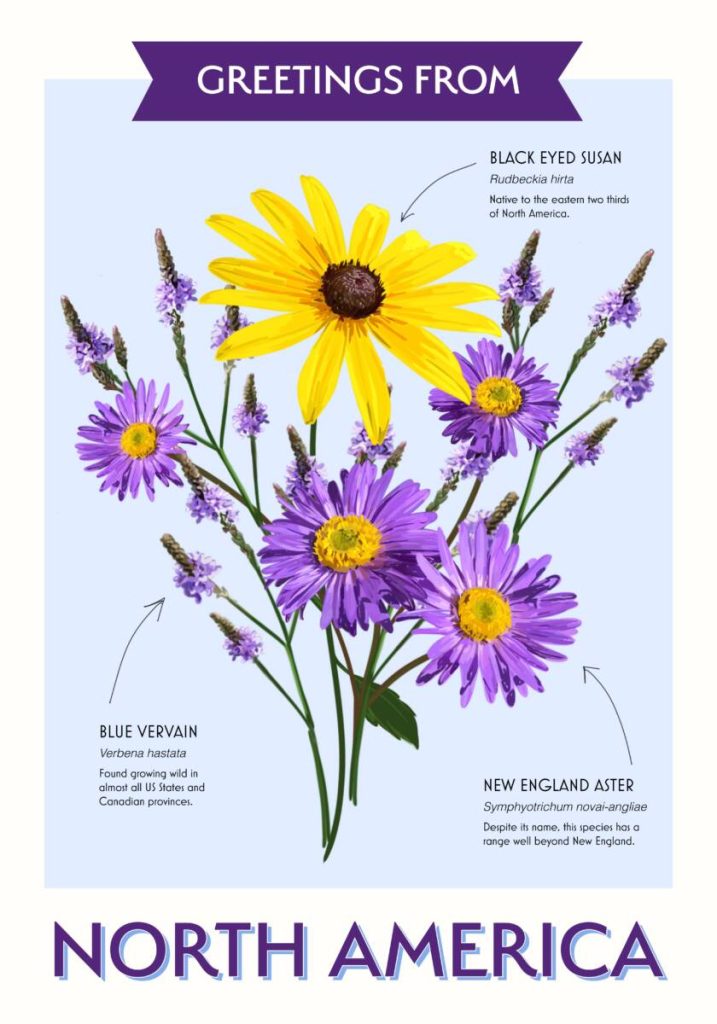
The first stop on our tour is North America – the world’s third-largest continent. In the centre of our North American bouquet is the Black Eyed Susan (Rudbeckia hirta) which is native to the Eastern two-thirds of North America. This bright sunflower-like flower typically blooms in the summertime and lasts until the first frost, although it can sometimes be treated as an annual in the southernmost states.
The second flower of our bouquet is the New England Aster (Symphyotrichum novae-angliae) which brings an interesting purple pop to our North American bouquet. Despite what the name suggests, this flower has a range well beyond New England and can be found in many central and northeastern states, alongside southeastern regions of Canada. Unlike most other flowers which bloom in the summer and start to fade in autumn, this species of Aster is in full bloom during autumn and brings some much-needed colour to gardens later in the year.
The final flower featured in our North American bouquet is the Blue Vervain (Verbena hastata) which is typically found growing wild in almost all US states and Canadian provinces. Alongside its striking looks, this flower is thought to have great health benefits because of the compounds within its chemical make-up and is used by believers in folk medicine as an herbal remedy for anything from anxiety to gut health issues.
What to see in North America
There are countless picturesque sights to explore while cruising around North America. You can visit beautiful West Coast destinations such as San Francisco and Seattle, or sail down the East Coast starting with the Big Apple and ending in Miami. Whichever cities and states are included in your adventure, you’re sure to tick off some of the world’s top attractions.
North America is home to the iconic Golden Gate Bridge, the Miami Beach resort, and the Empire State Building. But aside from all the most famous sights, it’s also worth checking out the San Francisco Botanical Garden or Miami’s Fairchild Tropical Botanic Garden to learn more about the flowers in this part of the world.
Sources:
- https://gardenerspath.com/plants/flowers/best-native-wildflowers
- https://www.gardenia.net/genus/aster-novae-angliae-new-england-asters
- https://www.verywellhealth.com/vervain-health-benefits-4587384
South America
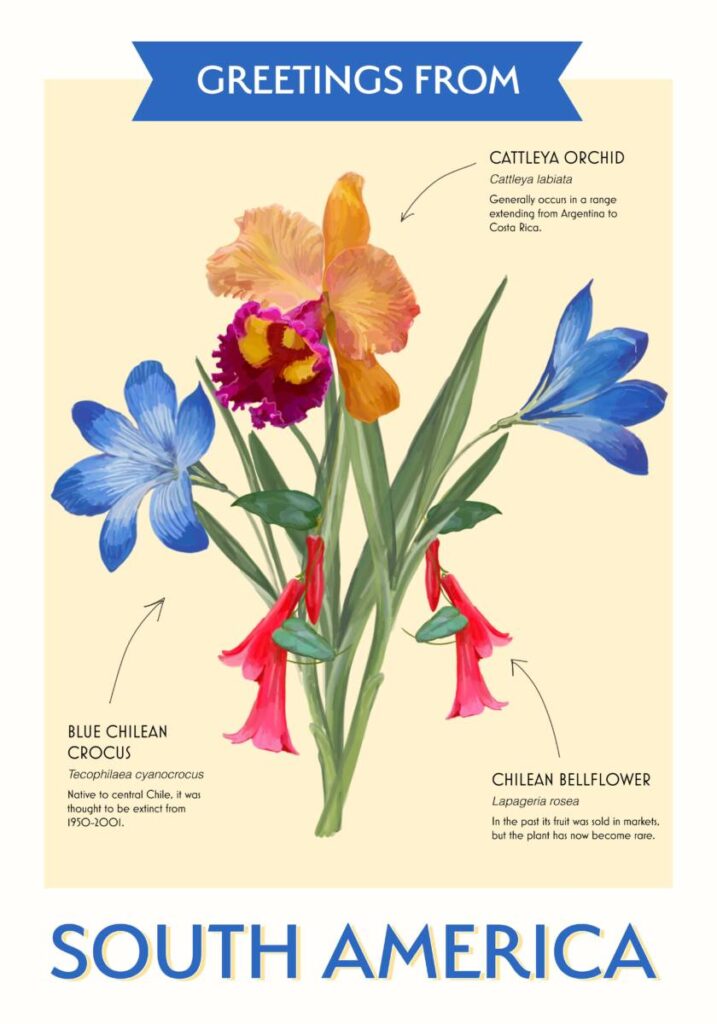
Although South America is just a stone’s throw away from North America, the variation in the climate is much more tropical here. This leaves room for entirely new and unique species of flowers to flourish, serving as a reminder of the incredible diversity of our planet.
For our South American bouquet, we’ve picked out the Blue Chilean Crocus, the Cattleya Orchid and the Chilean Bellflower. Sitting on the outer edge of our bouquet concept, the Blue Chilean Crocus (Tecophilaea cyanocrocus) is native to central Chile and was sadly thought to be extinct for more than half a century because of its rarity. Although it’s still a rare sight, the cobalt blue flower was spotted growing wildly on the continent and is no longer in danger of going extinct. It can typically be found in the Andes Mountain range on the dry and stony slopes, which makes it quite a hardy plant.
The flamboyant Cattleya Orchid (Cattleya labiate) is our second flower of choice and is typically found in a range extending from Argentina to Costa Rica. These orchids were popular in bouquets during the 50s because of their strong colours and vibrant scents, although they bloom for shorter periods than other species of this flower.
The final flower in our South American bouquet is the Chilean Bellflower (Lapageria rosea) which adds a contrasting pop of pink to the lower half of our collection. Unfortunately, this Bellflower is currently classified as endangered because of over-collection and landscape disturbances. The best way to enjoy this flower if you’re lucky enough to see it is to leave it alone and simply admire it as the foliage climbs nearby branches and shrubbery.
What to see in South America
The flowers aren’t the only beautiful things in South America – this continent is jam-packed full of stunning sights and exciting attractions making it the perfect for a cruise holiday. With colourful cities like Rio de Janeiro and Buenos Aires, visiting this part of the world is the perfect way to soak up the natural beauty, cultural diversity and incredible wildlife here.
Whether you’re hoping to experience the landscapes of Machu Picchu and parts of the Amazon Rainforest, or you’d rather immerse yourself in the vibrant cultures of Latin America, this pocket of the globe is buzzing with heritage and tradition.
Sources:
- https://adoptaseed.kew.org/seed/chilean-blue-crocus.htmlhttps://www.ourbreathingplanet.com/7-fabulous-south-american-plants/
- https://gardens.si.edu/collections/plants/orchids/orchid-care-sheets/cattleya/
- https://www.birminghambotanicalgardens.org.uk/lapageria-rosea-chilean-bell-flower/
Australasia
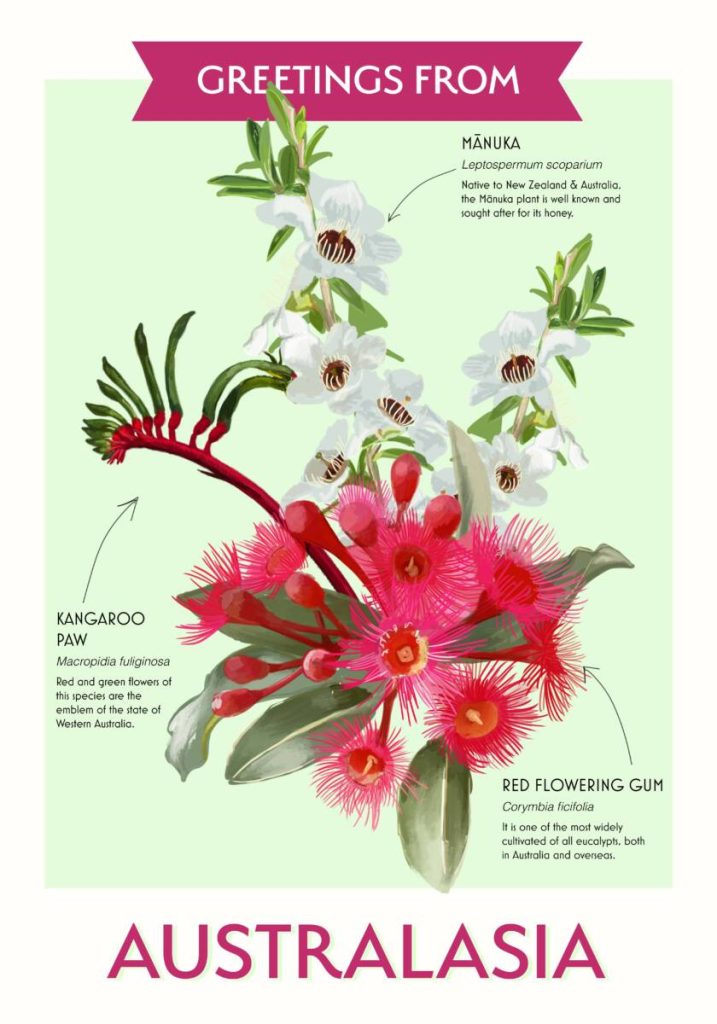
A few thousand miles away in Australasia you’ll find an entirely different set of landscapes filled with diverse foliage and flowers. So to celebrate this part of the world, we’ve created a bouquet bursting with hues of pink, red and green.
Our first flower of choice is the Red Flowering Gum (Corymbia ficifolia) which is one of the most widely cultivated of all eucalypts, both in Australia and overseas, which is impressive considering it’s only found growing naturally in the southwest of Western Australia. Flower buds always grow in groups of seven, although the colours can vary from reds to pinks and oranges.
Next, we have the Kangaroo Paw (Macropidia fuliginosa) which displays beautiful red and green shades and is often used as the emblem of Western Australia. The flower’s name comes from its visual similarities with a paw since the flowers bloom in a sequence next to one another.
To finish off the bouquet, we’ve included the Mānuka (Leptospermum scoparium). This flower is native to New Zealand & Australia and is the most well-known of our three picks because it produces extracts that create Manuka honey. Not only is this plant used to create food, beauty products, and health supplements, but it’s also nice to look at with its small pink and white blossoms and shiny green leaves.
What to see in Australasia
An Australasia cruise can offer fantastic experiences. Home to Australia, New Zealand and other stunning islands in the Pacific Ocean like Fiji and Papua New Guinea, there’s so much to explore.
Experience the rugged wilderness of New Zealand, the incredible marine life off the coast of Australia or the indigenous people of the region and their culture. However you choose to spend your time on the other side fo the world, you won’t be disappointed. Mix your sightseeing in with a few hiking trips around the countryside or visit some of the region’s most impressive botanical gardens.
Sources:
- https://en.wikipedia.org/wiki/Corymbia_ficifolia
- https://en.wikipedia.org/wiki/Anigozanthos_manglesii#
- https://www.kew.org/plants/manuka
Europe
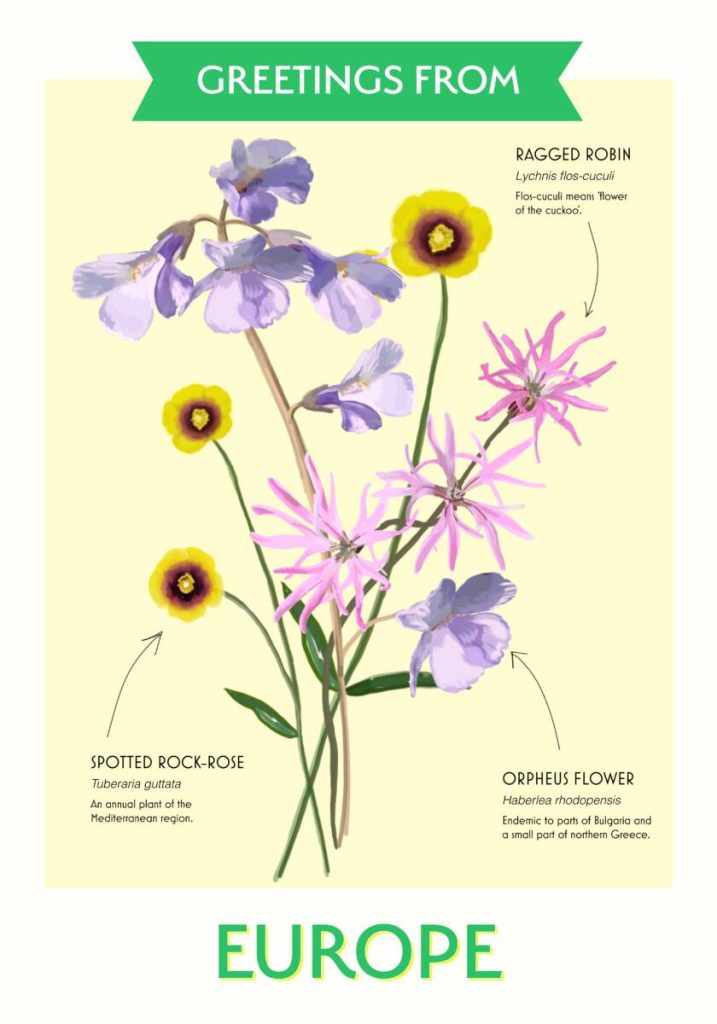
The next stop on our tour is Europe with its varied landscapes and climates, and equally varied wildlife to match. When creating our bouquet, we thought it would only be right to include a diverse assortment of flowers that grow across the continent.
Our first pick for the bunch of flowers is the Spotted Rock-rose (Tuberaria guttata) which is an annual plant typically found in the Mediterranean region. This flower coined its name because it emerges through gaps between rocks and stones in the ground, revealing a striking yellow rosette-style bloom that only lasts for a short amount of time.
Next, we’ve included the Orpheus flower (Haberlea rhodopensis) which is endemic to parts of Bulgaria and a small area of northern Greece. This flower is sometimes called the ‘resurrection plant’ because of its ability to survive over long periods, which brings a beautiful purple flair to the gardens for much of the year in this region.
The Ragged Robin (Lychnis flos-cuculi) brings the finishing touches to our European bouquet. The ‘Flos-cuculi’ part of its name means ‘flower of the cuckoo’, and this flower is common across the UK. It thrives in boggy areas and attracts all kinds of wildlife, including butterflies, dragonflies and bees.
What to see in Europe
A cruise around Europe is the best way to see this incredible set of countries and all its wonders. From the wild meadows of the UK to rugged coastlines in Spain and Italy, there’s no better way to explore this part of the world than on one of the world’s cruise lines. Stroll through cities like Rome, Budapest and Dubrovnik bursting with history and great food, not to mention the beautiful weather if you time it right.
So, whether it’s island hopping through Greece or cycling along Amsterdam’s canals, there’s beauty in every corner of Europe just waiting to be discovered.
Sources:
- https://en.wikipedia.org/wiki/Tuberaria_guttata
- https://en.wikipedia.org/wiki/Haberlea
- https://www.wildlifetrusts.org/wildlife-explorer/wildflowers/ragged-robin
Africa
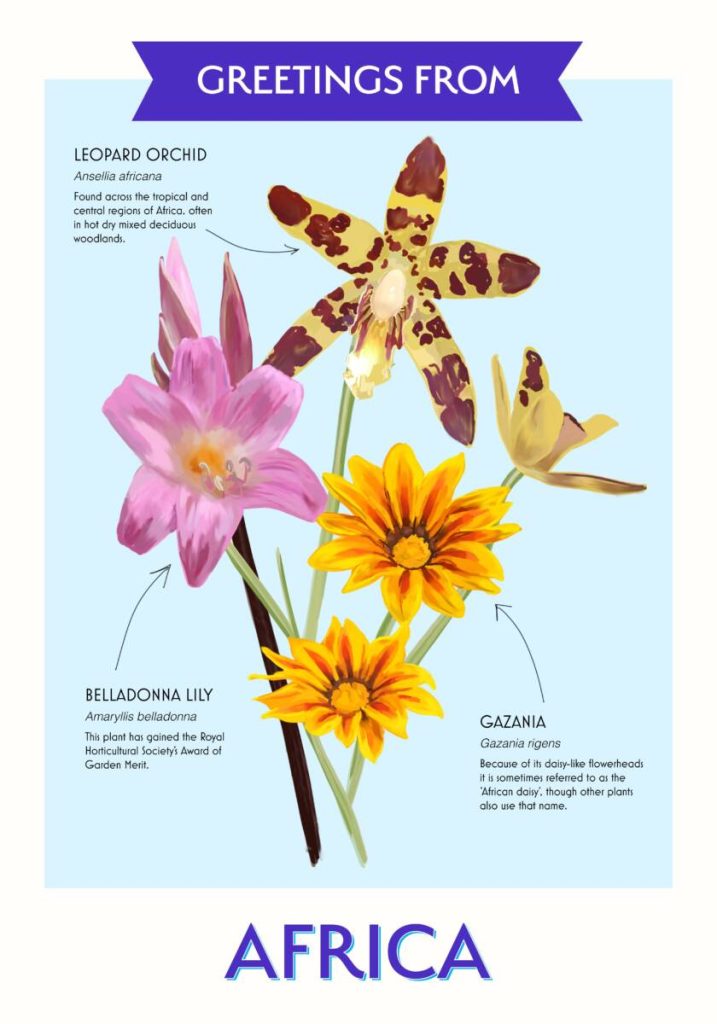
Bright colours are on the agenda for our African-inspired bouquet. Up first is the Leopard Orchid (Ansellia africana), which is most commonly found across tropical and central regions of Africa where the climates are hot and dry. Similar to other orchids, it tends to grow around tree branches and use these to prop itself upright. It also gets its name from the leopard-like colourings which are unique for each flower.
Our second flower choice is the Gazania (Gazania rigens), which can sometimes be referred to as the ‘African daisy’ because of its daisy-like flower heads. This flower thrives in hot and sunny parts of South Africa, and the distinctive orange and yellow hues of it mean that it’s impossible not to notice.
We also included the Belladonna Lily (Amaryllis belladonna) in our African bouquet with its wonderful pink bloom. This gorgeous lily has gained the Royal Horticultural Society’s Award of Garden Merit and although it’s native to Cape Province in South Africa, it can also be found around the world due to its immense popularity.
What to see in Africa
An African adventure by sea is a great way to capture the essence and beauty in this part of the world. Not only can you see flowers and foliage that exclusively grows in this region, but there’s an abundance of incredible experiences to be had here. From Kruger and Serengeti National Parks that are home to one-of-a-kind safari tours, to Table Mountain and Valley of the Kings, there’s a world of culture and history waiting to be uncovered.
Sources:
- https://www.worldlandtrust.org/species/plants-2/leopard-orchid/
- https://www.gardenersworld.com/how-to/grow-plants/how-to-grow-gazanias/
- https://en.wikipedia.org/wiki/Amaryllis_belladonna
Asia
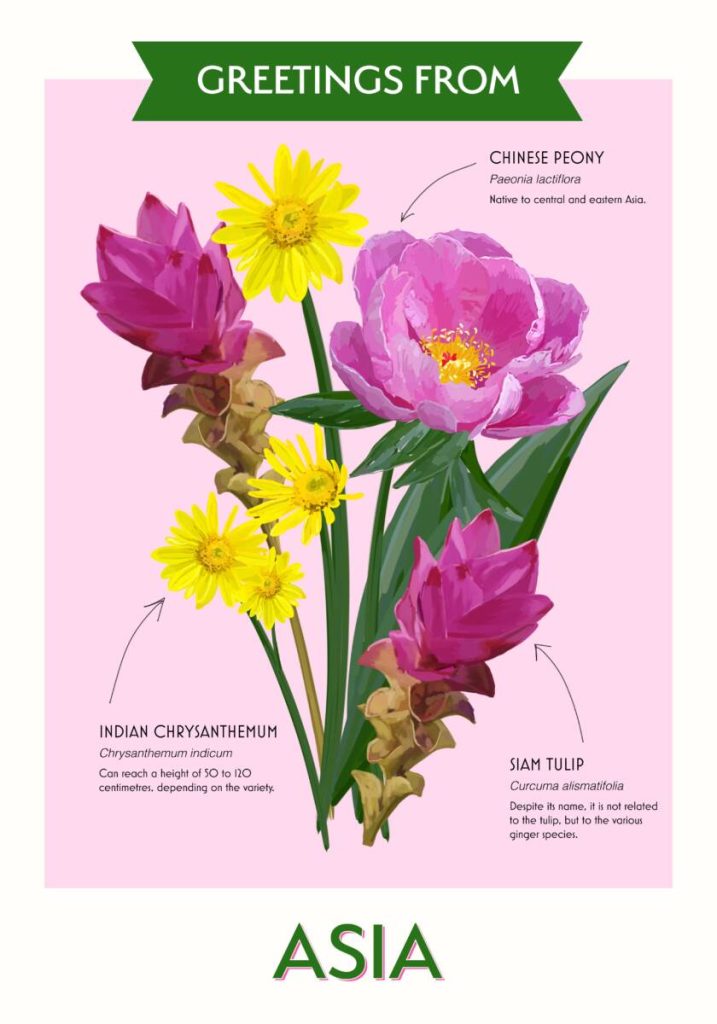
Over in Asia, there were endless options to choose from for our bouquet concept. It took some deliberation, but we’ve managed to whittle it down to three – the Chinese Peony, the Siam Tulip and the Indian Chrysanthemum.
The Chinese Peony (Paeonia lactiflora) is native to central and eastern Asia and stands tall and bright with hues of purple, yellow and orange. This flower rose to popularity during the Edwardian era, although it’s still one of our favourites from the continent. The Siam Tulip (Curcuma alismatifolia) is the second flower featured in our Asian bouquet, although it isn’t related to the tulip despite its deceiving name. This flower is actually closely related to the various ginger species and thrives in tropical environments like Northern Thailand and Cambodia.
Our final pick is the Indian Chrysanthemum (Chrysanthemum indicum) which can reach staggering heights of up to 120 centimetres, depending on the variety. This pretty daisy-like plant features baby-pink petals and blooms from summer until autumn, but it isn’t just something nice to look at since many in the region pick the heads and pickle them to use as a condiment in Asian cuisine.
What to see in Asia
Like the look of our bouquet concept? Why not immerse yourself in an exciting cruise around Asia’s highlights and see how many you can spot growing wild? With destinations like Thailand, Japan and Malaysia, you have the chance to see colonial buildings, iconic districts and historic monuments – not to mention the countless beauty spots on offer.
A cruise around Asia offers the perfect mix of culture, cuisine and nature, with the old meeting the new in awe-inspiring ways.
Sources:
- https://www.gardenersworld.com/plants/five-types-of-peony-to-grow/
- https://en.wikipedia.org/wiki/Curcuma_alismatifolia
- https://www.rhs.org.uk/plants/157673/chrysanthemum-indicum/details
Antarctica
Because of the climate and landscape in this part of the world, Antarctica understandably doesn’t seem to have a range of flowering plants, which is why we’ve been unable to create a bouquet concept. Much of the Antarctic is too cold for trees or shrubs to grow, although two species of flowering plants can be found on the South Orkney Islands, the Southern Shetland Islands and along the western Antarctic Peninsula. These are the Antarctic Hair Grass (Deschampsia antarctica) and Antarctic Pearlwort (Colobanthus quitensis). Lower plant groups such as mosses, fungi, lichens and liverworts that are adapted to surviving in extreme environments are among the only plant life found on this continent.
What to see in Antarctica
Despite the lack of greenery and plant life, there are still plenty of other exciting wonders here for us to celebrate. From natural glaciers and ice-covered landscapes stretching for hundreds of miles to exciting species like whales and penguins, Antarctica is a destination that offers each visitor a completely unique experience each time. Many cruises in this area also offer discovery experiences for passengers to gain insight from groups of scientists who dedicate their working lives to studying the Antarctic region. You can hop into a small boat, ask questions and simply observe nature in this raw form. It certainly makes for a magical holiday you’ll never forget.
Sources:
Although we love these bouquet concepts, please remember that we aren’t encouraging anybody to re-create these bouquets or put these flowers together. We’re simply celebrating the flowers native to and found in different parts of the world.
Why not book a cruise and discover a few of these exciting plants and flowers for yourself? Whether you’re sailing around South America in hopes of spotting the Blue Chilean Crocus or travelling around Australasia with its Kangaroo Paw, you’re sure to have a fabulous time.

